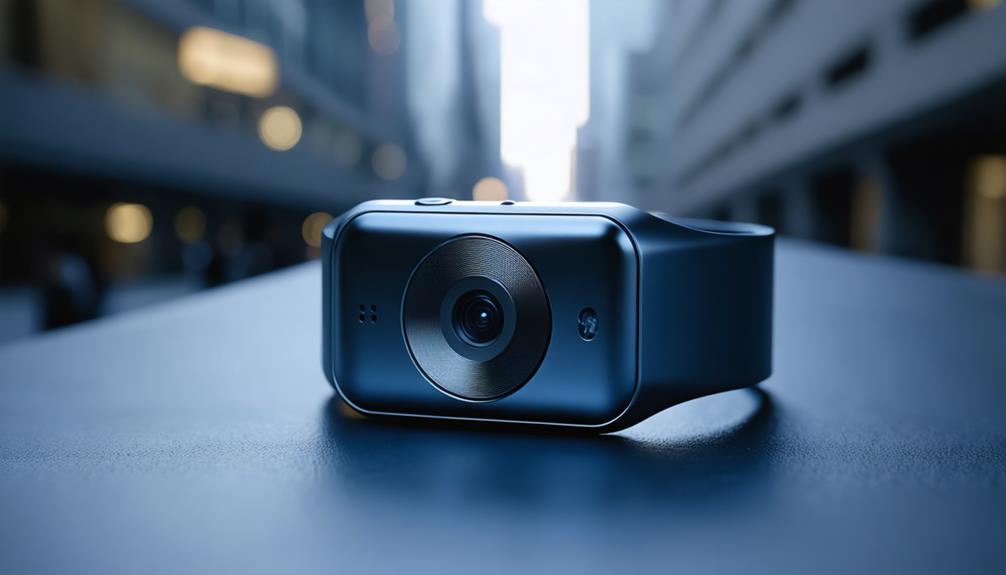
Brainstorm Security Shop

For Orders Over $199

On Any Of Our Products

Details On Refund Page
The evolution of wearable cameras from cumbersome gadgets to sophisticated, compact devices marks a significant milestone in personal technology. These modern cameras, exemplified by the GoPro Hero and Insta360 One, seamlessly integrate advanced features such as high-resolution video and user-friendly interfaces. As they become indispensable tools for personal safety, fitness, and travel, one must consider the implications of their pervasive presence in daily life. What are the ethical considerations surrounding privacy and data security? And how might these innovations shape future trends in wearable technology? The answers to these questions could redefine our interaction with digital media.
Since their inception, wearable cameras have undergone significant transformations, driven by advancements in technology and changing consumer demands. The history timeline of wearable cameras dates back several decades, with early iterations often bulky and limited in functionality. In the late 20th century, the introduction of compact video recording devices marked a pivotal moment, allowing users to capture footage more conveniently.
The early 2000s saw a surge in technological advancements, as digital technology began to replace analog systems. This period witnessed the miniaturization of components, which facilitated the development of more portable and user-friendly devices. High-resolution capabilities and improved battery life became focal points, significantly enhancing the user experience.
The evolution continued into the 2010s, driven by the increasing popularity of social media and a growing interest in personal documentation. Wearable cameras became more integrated with smartphones, offering seamless connectivity and real-time sharing options. Innovations such as action cameras and 360-degree recording expanded the horizon of possibilities for users, catering to both professional and recreational needs.
In recent years, developments in artificial intelligence and machine learning have further refined wearable cameras. These technologies enable enhanced features like facial recognition and real-time editing, underscoring the relentless pace of progress within this dynamic field.
When evaluating wearable cameras, several key features warrant careful consideration to ensure the device meets user needs effectively.
First, image quality is paramount; a camera must deliver sharp, clear visuals to be truly valuable. Look for options offering high-resolution video and photos, which can significantly enhance the viewing experience.
Battery life is another essential factor, influencing how long the device can operate without recharging. A longer battery life ensures extended functionality, especially during prolonged activities.
The user interface should be intuitive, allowing for seamless operation. A complex interface can hinder usability, detracting from the overall experience.
Mounting options are critical as well, providing flexibility in how and where the camera can be attached, whether on a helmet, clothing, or other equipment.
Connectivity features, such as Wi-Fi or Bluetooth, enable easy transfer of footage to other devices, facilitating quick sharing and editing.
Storage capacity determines how much footage can be retained before needing to offload files, so ample space is advantageous.
Durability ratings indicate the camera’s ability to withstand elements like water and impact, ensuring longevity.
Lastly, ease of use ensures that users can swiftly operate the device without extensive learning curves.
Several wearable camera models have gained popularity in the market due to their advanced features and user-friendly designs. Among the most notable are the GoPro Hero and Insta360 One, which have set benchmarks for versatility and performance.
The GoPro Hero series is celebrated for its rugged construction and exceptional video quality, making it a favorite among adventure enthusiasts. Its compact design and waterproof capabilities allow users to capture high-definition footage in challenging environments. With features such as HyperSmooth stabilization and voice control, the GoPro Hero ensures seamless user experiences, catering to both amateur and professional videographers.
On the other hand, the Insta360 One stands out for its innovative 360-degree capture technology, providing users with a comprehensive view of their surroundings. This model is particularly popular among content creators who value immersive video content.
The Insta360 One’s FlowState stabilization ensures smooth footage, while its compact form factor makes it an ideal choice for those seeking portability without sacrificing quality. Additionally, the Insta360 One’s compatibility with various accessories enhances its functionality, allowing users to adapt it to a range of scenarios.
Together, these models exemplify the cutting-edge capabilities of modern wearable cameras.
Wearable cameras frequently play a significant role in enhancing daily life by providing practical solutions for various activities. One key application is personal safety, where these devices allow for real-time recording of surroundings, offering peace of mind during walks or commutes.
Hands-free recording is another benefit, enabling users to capture moments without distraction. This is particularly useful for adventure documentation, where outdoor enthusiasts can record hiking, biking, or extreme sports without interrupting their activities.
Fitness tracking is enhanced by wearable cameras, which can monitor and analyze exercise routines, offering visual feedback for improvement.
Creative storytelling is facilitated through these devices, as individuals can document daily experiences in innovative ways, transforming mundane moments into compelling narratives. Social sharing becomes seamless, with users effortlessly uploading videos and photos to social media platforms, allowing for instant connection with others.
Pet monitoring is another practical use, as wearable cameras enable pet owners to keep an eye on their animals remotely, ensuring their well-being.
Lastly, travel photography is revolutionized by wearable cameras, which offer the ability to capture high-quality images and videos without the need for bulky equipment, making documenting journeys more convenient and spontaneous.
As technology advances, the future of wearable technology promises a seamless integration into daily life, enhancing functionality and user experience. One of the most anticipated trends is the incorporation of augmented reality (AR) into wearable devices, providing users with immersive experiences that blend the digital and physical worlds. This could revolutionize fields such as education, navigation, and entertainment, offering real-time information overlay.
Health monitoring remains a critical focus, with wearables poised to offer more sophisticated tracking of vital signs, leading to proactive healthcare solutions. However, these advancements raise significant privacy concerns, as the increased collection and analysis of personal data necessitate robust security measures to protect user information.
Improving battery life is another key trend, as users demand longer-lasting devices that do not compromise on performance. Simultaneously, innovations in data storage will allow for more efficient handling of the vast amounts of information generated by these devices.
Social sharing features will likely continue to evolve, enabling users to effortlessly share experiences without sacrificing privacy.
Design innovation will also play a crucial role, focusing on creating aesthetically pleasing and functional wearables that seamlessly integrate into everyday life, enhancing the overall user experience.
Surveillance ethics and consent challenges significantly impact privacy and data security. The proliferation of recording devices raises concerns regarding unauthorized data collection and potential misuse, necessitating stringent regulatory measures to ensure ethical data handling and protect individual privacy rights.
The legal implications of public recordings are complex, often necessitating adherence to consent laws. These laws vary by jurisdiction, impacting how recordings can be conducted and shared, emphasizing the need for awareness of local legal requirements.
The battery lifespan varies, generally lasting between 4 to 12 hours depending on usage and model. Charging options often include USB connections, portable power banks, or docking stations, enhancing flexibility for extended operational needs.
Yes, devices designed for live streaming and remote monitoring can facilitate real-time data transmission. These technologies typically support continuous connectivity, allowing users to broadcast live footage and monitor environments from remote locations seamlessly and efficiently.
Proper maintenance involves regular lens cleaning to ensure clear image capture and prevent debris buildup. Additionally, ensure timely software updates to enhance functionality and security, thereby extending the device’s lifespan and maintaining optimal performance.
